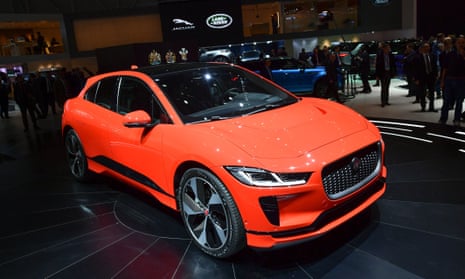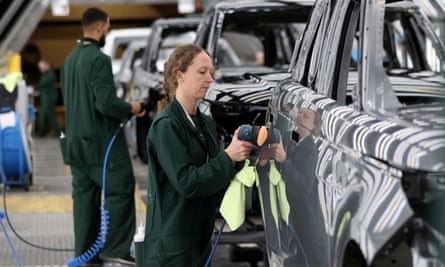
How Jaguar Land Rover fell behind in the race to an electric future – and what it means for the UK
There are fears for UK industry as a whole as the country’s carmaking champion falls further behind wealthy rivals in the race for zero-emission vehicles
About 20 firefighters, some wearing breathing apparatus, were called to a fire at a test facility near Jaguar Land Rover’s Midlands headquarters in January. A machine welding a prototype battery for its bestselling Range Rover was the cause of the blaze, which the carmaker described as “minor”.
Battery fires are not uncommon, particularly in testing, but it was a reminder of the perils facing carmakers as they try to switch to electric power after a century of the combustion engine. It was also a reminder of how far Britain’s carmaking champion has fallen behind in that global battery race.
After a torrid four years of losses, sluggish sales, pandemic turmoil and boardroom upheaval, all eyes are on how it will make the belated transition to electric cars – and if it can catch up with its giant rivals.
Jaguar Land Rover’s approach over the next few years will go a long way in determining the UK’s status as a carmaking nation, and the jobs of 780,000 people employed in its car factories, the wider supply chain and sales industry. Of these, the Coventry-based carmaker employed 36,000 in March 2022, with most in the West Midlands automotive heartland. It is also hugely important for the British supply chain: an anchor customer that – along with Japan’s Nissan in Sunderland – can produce several hundred thousand cars every year.
Gigafactory
Jaguar Land Rover has been owned by Tata Motors, part of the same Indian conglomerate that owns the Port Talbot steelworks and Tetley Tea, since it was bought from Ford in 2008 for $2.3bn (£1.15bn at the time).
Ministers are acutely aware of Tata’s importance and negotiating power, and government officials are wrangling with it over hundreds of millions of pounds of state aid for two interlinked fronts: a £300m offer of support for upgrading the south Wales steelworks’ blast furnaces, and a reported £500m request from Tata for aid in building a battery “gigafactory”.
Tata is thought to be choosing between the UK and Spain for the factory, which would have JLR as its anchor customer. One person with knowledge of JLR’s thinking suggested the UK’s financial offer was competitive with other governments, but “energy prices are prohibitive – the problem is the energy costs”. There is also scepticism about the economics of ferrying batteries hundreds of miles between factories.
David Bailey, professor of business economics at the University of Birmingham, said the choice of Spain for a Tata gigafactory would “leave a heck of a question mark over the UK’s industrial strategy, if it can’t even attract JLR”.
Unions are furious that the Westminster government has introduced one of the earliest bans on combustion engines, prohibiting the sale of new petrol and diesel cars from 2030, and hybrid vehicles from 2035, without offering the same support as EU rivals for companies to upgrade to electric vehicle technology. The US carmaker Ford last month cut 1,300 jobs in the UK, mostly to do with nearly defunct combustion engine technology. Honda shut its Swindon car plant in 2021.
Joe Biden’s $369bn Inflation Reduction Act has turbocharged a subsidy race between the US and the EU, luring carmakers such as VW to open vast factories capable of producing hundreds of thousands of batteries a year.
“It’s time for the government to stop worrying about saving itself and start saving the UK automotive industry,” said Des Quinn, Unite’s national officer for the automotive industry. “An electrified supply chain and a gigafactory [would] anchor manufacturers of cars in the UK.”
Leadership turmoil
As aA bellwether for British industry, JLR’s deteriorating fortunes reflect wider decline in manufacturing, which contributes about a tenth of GDP. Its last year of profit was in 2018. Former boss Ralf Speth once boasted of plans to build a million cars a year – with factories in India, Brazil and China – and create a British premium rival to Mercedes-Benz and BMW.
However, VW’s dieselgate emissions-rigging scandal undermined demand just as JLR invested heavily in a new engine factory in the Midlands. Then the Chinese sales bubble popped, and in 2019 JLR was forced to write down the value of investments by £3.1bn. Speth left the company, bleeding losses and over-extended, in 2020.
Thierry Bolloré, the former boss of Renault, took over and started reversing Speth’s “dash for growth”: instead he aimed to lower the number of cars needed for the company to generate cash. There have since been several senior departures. In 2021, Jaguar designer Julian Thomson left after two years, as did Nick Rogers, the director of product engineering, and sales boss Felix Bräutigam. In 2022 they were followed by Grant McPherson, executive director of manufacturing, as well as supply chain executives Neil Marsons and David Owen.
Bolloré himself left in December after only two years. The company cited “personal reasons”, although several people close to the company said his departure may have been influenced by its response to the global semiconductor shortage triggered by the coronavirus pandemic, which left JLR unable to produce enough cars to meet demand.
Adrian Mardell, a longstanding executive who is well respected within JLR, was made interim boss. A senior automotive industry source said Tata was giving him time to prove himself in the role, and had not launched a concerted effort to recruit externally.
In January, Mardell told investors the company now only needed to make 300,000 cars a year to break even – a number that has dropped significantly from 660,000 in 2019.
Chip shortages
On the surface JLR likes to boast of cost cuts and insatiable demand that has led to a record order book of more than 200,000 cars. Yet part of that backlog is down to its inability to meet demand: while rivals BMW and Mercedes-Benz have made record profits by focusing on its most profitable models, JLR has been held back by the microchip shortage.
JLR too has prioritised the more expensive and profitable Range Rover, Range Rover Sport and newer Defender models. However, it still took until January for it to record its first quarterly profit – £265m – since the end of 2020. That followed four years of cumulative losses totalling £5bn.
Jim Williamson and Mark Ryan, analysts at Creditsights, a debt ratings agency, believe that JLR should be able to increase sales and get through its order book, but note there is uncertainty around consumer demand and a “spotty track record of execution by management in the past”.
after newsletter promotion

A spokesperson said JLR planned to turn into “an all-electric modern luxury business and deliver our science-based … climate goals, and over the next three years we will invest £3bn per annum to deliver our plans.
“Despite the post-pandemic global challenges of inflation, chip shortages and high energy prices, we are accelerating our strategy and returned to profit this year,” the spokesperson said. “Demand for our vehicles is strong, with our three most profitable models – the Range Rover, Range Rover Sport and Defender – accounting for over 74% of our order book.”
Electric, eventually
Suppliers have also been hurt by stop-start production, and express deep uncertainty over JLR’s longer-term direction, and particularly about when it will start to build more of its electric models. Its one battery model, the Jaguar I-Pace, was garlanded with World Car of the Year after its launch in 2018, but it was never followed up. Meanwhile deep-pocketed rivals have launched a proliferation of electric models, with VW alone spending €89bn on electrification and software.
JLR will shortly embark on its second serious attempt at electrification. Speth had planned to build an electric version of the Jaguar XJ – the executive car that until recently ferried the prime minister around. (It was replaced by a German Audi.) A person who worked on it talks of attractive split headlights, a panoramic glass roof and huge doors. Bolloré canned it, but pledged to make Jaguar an electric-only brand by 2025.
The company needs to do something: sales of Jaguars have dwindled from more than 180,000 in 2018 to 65,000 in 2022, according to data company LMC Automotive. They have not been helped by competition from within JLR: SUV sales were cannibalised by the cheaper Range Rover models.
Mardell is pushing ahead with Bolloré’s strategy of driving Jaguar upmarket. That comes with risks, said Bailey. “Going luxury means very low volume, very high prices,” he said. “It’s a complete departure for them as a brand.” The chief executive at a large manufacturer said: “JLR has a big challenge. If I were running that company I wouldn’t keep on the Jaguar brand.” JLR’s spokesperson said: “Our plans for the renaissance of Jaguar are on track.”
Land Rover sales are not struggling in the same way, but they too will have to adapt to bans on internal combustion engines. The first battery Range Rover will finally arrive next year, but JLR will not sell 100% zero-emission cars (which could also include hydrogen fuel-cell vehicles) until at least 2036.
However, JLR is keeping its options open. The larger Range Rover and Range Rover Sport will be built using a tooling system in a factory in Solihull that will allow JLR to switch relatively easily between hybrids (combining a fossil fuel engine and a battery) and pure battery options.
Quick Guide
Electric avenue: Jaguar Land Rover’s road to net zero
Show
2022
New Range Rover manufacturing system introduced.
2024
First Range Rover battery car.
2025
Next Jaguar battery car.
2030
All models available with batteries.
2036
100% sales of zero-emission vehicles.
2039
Jaguar Land Rover net zero carbon emissions.
“The flexible approach is a must for Land Rover as they do not have the scale or resources to just build a battery electric factory and wait for the sales to climb,” said Charles Tennant, a former engineer at Land Rover who later as an academic helped persuade Tata to buy JLR in 2008. That could prove a canny bet if carmakers successfully push back against internal combustion engine bans, particularly in the US. “I do think their rate of move to full EV is going to be slightly lower than people think,” said a person who has worked with JLR.
Smaller, cheaper Land Rovers will be built at Halewood on Merseyside, with a long shutdown expected in 2024 to update the factory. As part of that plan, JLR is considering moving production of the next Land Rover Discovery from Slovakia to the UK, according to a person with knowledge of internal discussions. That move, which has not been confirmed, would provide a welcome boost for the British car industry.
The problems of recent years have repeatedly highlighted an inescapable problem for JLR: it doesn’t have the scale of bigger rivals in Germany or Asia. An executive at another carmaker said: “They’ve made a strategy and it’s very articulate, and it’s very clear. You’re in the realm of ‘will it work?’ Will it work without a big brother or sister?”
What is clear is that Jaguar Land Rover is gearing up for a smaller future. The hope is that the UK car industry can avoid the same fate.